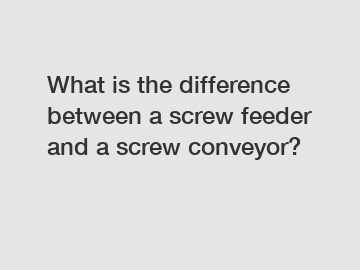Dec. 19, 2023
Machinery
What is the difference between a screw feeder and a screw conveyor?
Screw feeders and screw conveyors are often confused with each other due to their similar appearance and function. While both devices are used for the purpose of moving materials, they have distinct differences that set them apart. In this article, we will delve into the dissimilarities between screw feeders and screw conveyors, exploring their unique features, applications, and benefits.
Screw feeders and screw conveyors play a crucial role in various industries, such as agriculture, mining, and manufacturing, where the movement of bulk materials is required. However, their specific functionalities and design characteristics make them suitable for different applications.

1. Design and Construction:
Screw feeders are designed to control the rate at which materials are fed into a process. They consist of a rotating screw, also known as an auger, enclosed in a cylindrical casing. This design prevents material flow from the inlet to the outlet without the rotation of the screw. The speed and torque of the screw can be adjusted to regulate the material feed rate.
On the other hand, screw conveyors are primarily used for transporting materials from one location to another within a processing system or plant. They consist of a helical screw, housed in a tube-like structure, allowing materials to move from the inlet to the discharge end. The screw rotates to propel the material forward, enabling efficient transportation of bulk substances.
2. Material Handling Capacity and Applications:
Screw feeders are commonly employed for precise volumetric feeding, handling small to moderate quantities of material. Industries like food processing, pharmaceuticals, and chemical processing often utilize screw feeders for controlled ingredients or additives feeding. These devices excel in accurately and consistently supplying materials to downstream processes.
Screw conveyors, on the other hand, are designed to handle much larger quantities of material compared to screw feeders. They are used for operations such as bulk material handling, packaging, elevating, and mixing. The versatility of screw conveyors allows them to effectively handle a wide range of materials, including powders, granules, and even semi-solid substances.
3. Flexibility and Customization:
Screw feeders are typically manufactured as standalone units and are available in various sizes and configurations to meet specific application requirements. They can be customized to accommodate different material properties, such as flow characteristics, moisture content, and particle size. The design variations allow screw feeders to be adapted for use in highly specific industries and processes.
Screw conveyors, on the other hand, offer even greater flexibility and customization options. They can be tailored to fit a particular layout, occupying less space or functioning in combination with multiple conveyors. Moreover, screw conveyors can be designed to have inclined or vertical orientations, enabling them to traverse different terrains and overcome height restrictions within a production facility.
4. Operational Considerations and Benefits:
Screw feeders and screw conveyors offer several advantages that improve operational efficiency and productivity. Screw feeders provide precise and controlled material feeding, reducing wastage, ensuring accurate proportions, and preventing material surges. They are considered ideal for applications that require continuous, uninterrupted feeding.
In contrast, screw conveyors offer continuous material transportation, reducing manual handling and streamlining processes. They are often lauded for their ability to handle a wide range of materials, enabling seamless integration into diverse production lines. Screw conveyors also have low power consumption, making them energy-efficient and cost-effective solutions.
In conclusion, understanding the differences between screw feeders and screw conveyors is crucial for selecting the appropriate equipment for material handling requirements. While screw feeders control the feeding rate with precision, screw conveyors excel in transporting large quantities of materials efficiently. Both devices offer unique benefits and customization options, ensuring seamless integration into various industries and applications. So, next time you encounter these fascinating mechanical wonders, you'll know exactly how they differ and what purpose each serves in the world of industrial material handling.
Want more information on cost-effective glue dispenser machines, Automatic Riveting Machine, Auto Feeding Manual Screwdrivers? Feel free to contact us.
Previous: SMT PCB De-stacker Loader: Boost Manufacturing Efficiency & Overcome Production Bottlenecks!
If you are interested in sending in a Guest Blogger Submission,welcome to write for us!
All Comments ( 0 )